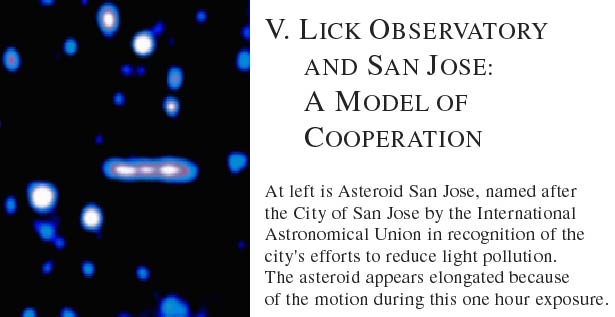


UNIVERSITY OF CALIFORNIA OBSERVATORIES / LICK OBSERVATORY


Several public agencies have recognized the scientific and economic value of developed observatory sites. The county government of the Big Island of Hawaii, and, in Arizona, the cities of Tucson and Flagstaff, and Pima county have all adopted lighting ordinances with the needs of nearby observatories in mind.
Lick Observatory and San Jose enjoy a long history of cooperation. In 1980, when San Jose replaced Mercury vapor street lights because of energy considerations, Lick was closely involved with the choice of the LPS replacement type. This has allowed Lick to continue forefront research in spite of the growth of San Jose. The policy adopted at that time by the City of San Jose specified LPS lighting for street lights throughout the City except for the Downtown Core Business District, where HPS lighting would be used. HPS lighting was used in the Downtown area primarily for aesthetic reasons. It provides a more natural lighting environment for areas used during the evening by pedestrians. The Arena vicinity is also now included in this exception area.
In studies undertaken at the time San Jose's policy was adopted, it was concluded that LPS was more energy efficient (cheaper) and that it did not have a negative impact on public safety or law enforcement. In fact, the conclusion was made that both HPS and LPS might actually aid law enforcement because they would increase the level of lighting and/or disperse light over a greater area than current lighting. An additional motivation for San Jose to choose LPS for the majority of its street lighting was the enormous benefit to the operations of Lick Observatory. Modifications have been made to the policy since that time so that HPS lighting could be used in restricted areas (i.e. Neighborhood Business Districts) where the city wants to encourage evening pedestrian use. A few years after San Jose adopted LPS as the street lighting standard, the City also required new or revised private developments (like shopping centers and malls) to use LPS in their parking lots. Lick Observatory greatly appreciates San Jose's current lighting policy. It has allowed us to conduct forefront research from Mt. Hamilton and to plan for future developments at the Observatory. For example, in the last few years, two unique, multi-million dollar instruments have come on-line at Lick. The Multi-Object Spectrograph (MOS) is designed to take spectra of over fifty faint objects simultaneously. The Prime Focus Camera (PF Cam) is designed to do direct imaging at the faintest possible limit. Both instruments were designed to operate taking advantage of San Jose's LPS lighting.
We welcome the continued support and cooperation of the City of San Jose, as well as other cities in the Valley, in efforts to reduce light pollution. How we light our streets today influences the success with which we probe the depths of the universe tomorrow.
